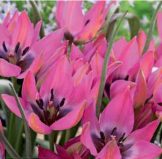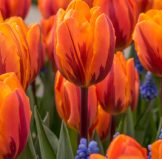Bulbs for Colorado Gardens
At Harlequin’s Gardens, we have been experimenting for years with bulbs in our display gardens. Since our gardens are xeriscapes (by default even where not by design), we have had the pleasure of discovering that a great many delightful bulbs can thrive and naturalize in our conditions and enliven the scene in spring and fall. No surprise, really, since most of these hardy spring and autumn-blooming bulbs originated in parts of the world with conditions much like ours, such as Central Asia. Visitors to our gardens have been wowed by enormous Star of Persia Alliums and brilliant sapphire miniature iris and charmed by perky miniature daffodils and starry species tulips and crocus. They (you) kept asking us “where can I get these?”, so in 2008, we carefully selected our first-ever offering of bulbs for sale at Harlequin’s Gardens.
Since then, we have added many wonderful varieties (Individual descriptions and images, below.) Quantities are limited and often sell out quickly. We recommend that you purchase your bulbs in September and hold them for planting when the soil is cooler (except Saffron Crocus and Crocus speciosus, which should be planted in September). Planting depths are to the bottom of the planting hole where the base of the bulb rests. Planting depth can vary depending on how light or heavy your soil is – plant deeper in light soils, shallower in heavier soils. As a general rule planting depth is 3 times the height of the bulb. Single Early, Triumph, Darwin Hybrid, and Multi-flowering tulips should be planted 8″ deep to perform as perennials and fertilized each year just after bloom. Be sure to allow the leaves and stems to wither naturally before cutting them down.
Here are some inspirations for ways and places to use bulbs that you may not have thought of. One idea is to plant small early-blooming bulbs, such as many of the species tulips, where the ground is exposed in spring but will be covered in summer by spreading herbaceous perennials like Desert Four-O’Clock (Mirabilis multiflora), ‘Orange Carpet’ California Fuschia (Zauschneria garrettii), or Wine Cups (Callirhoe involucrata). Also, meadows and drifts of ornamental grasses are usually dormant until mid to late spring and present a perfect stage for a brilliant display of many types of early spring bulbs. Deciduous groundcovers that emerge in mid-spring, like Plumbago (Ceratostigma plumbaginoides), can partner nicely with Iris reticulata and small species tulips.

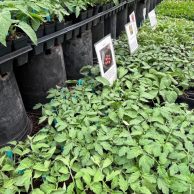 The Peppers are Coming!
The Peppers are Coming! 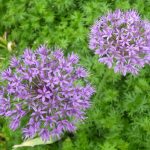
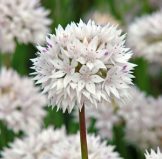 Circa 1857, this delicate-looking yet easy-growing North American native has composite 3″ globes of star-shaped, sparkling white flowers with pale lavender stamens tipped with purple anthers and sturdy stems.
Circa 1857, this delicate-looking yet easy-growing North American native has composite 3″ globes of star-shaped, sparkling white flowers with pale lavender stamens tipped with purple anthers and sturdy stems.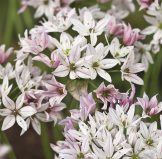
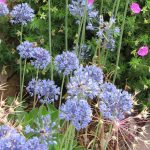 Allium caeruleum (syn. A. azureum) (Blue Globe Onion)
Allium caeruleum (syn. A. azureum) (Blue Globe Onion)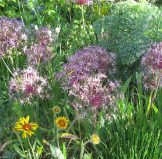 A most surprising, outrageous flower for xeriscapes! The giant globes, to 10” diameter or more, are held on fairly short stems, 8”-18” tall, blooming in mid-spring. The hundreds of starry, silver-lavender florets each have a green ‘eye’ are arranged so that their petal-tips touch to form a perfect sphere. This easy naturalizer has been highly successful in our xeriscape display gardens, eliciting lots of interest. Also spectacular in large flower arrangements, fresh or dried.
A most surprising, outrageous flower for xeriscapes! The giant globes, to 10” diameter or more, are held on fairly short stems, 8”-18” tall, blooming in mid-spring. The hundreds of starry, silver-lavender florets each have a green ‘eye’ are arranged so that their petal-tips touch to form a perfect sphere. This easy naturalizer has been highly successful in our xeriscape display gardens, eliciting lots of interest. Also spectacular in large flower arrangements, fresh or dried.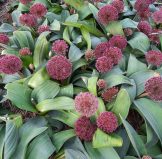
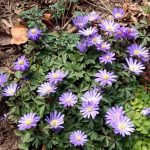 An enchanting, early-blooming member of the Buttercup family that grows from a tuber. Where happy, it spreads to form a carpet-like groundcover with ferny deep green foliage and 1”- wide open-faced sky-blue daisy flowers with yellow eyes. Provides a long-lasting display in early spring.
An enchanting, early-blooming member of the Buttercup family that grows from a tuber. Where happy, it spreads to form a carpet-like groundcover with ferny deep green foliage and 1”- wide open-faced sky-blue daisy flowers with yellow eyes. Provides a long-lasting display in early spring.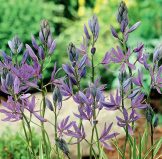
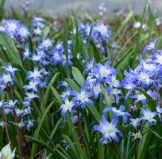 Blue Glory of the Snow is a deer proof bulb with compact 6-8” spikes of cheerful, white eyed, bright blue flowers in early spring. Chionodoxa is very attractive when planted in large drifts of many bulbs, and naturalizes readily.
Blue Glory of the Snow is a deer proof bulb with compact 6-8” spikes of cheerful, white eyed, bright blue flowers in early spring. Chionodoxa is very attractive when planted in large drifts of many bulbs, and naturalizes readily.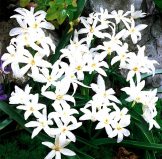 Lovely and easy, this naturalizing Glory of the Snow is among the first flowers of the year, and will succeed in most soils and locations, forming a spreading carpet of glistening white in very early spring. Each 6” stem holds 5 to 10 pure white starry flowers. Consider planting in lawns, under fruit trees, in open ‘woodland’ gardens, rock gardens, and to under-plant early Narcissus. Foliage disappears by late spring. Native to mountainsides in Western Turkey. Cold-hardy to Zone 3, sun to part shade, deer-resistant. Plant bulbs 3” deep and 2-3” apart or 9 bulbs per square foot.
Lovely and easy, this naturalizing Glory of the Snow is among the first flowers of the year, and will succeed in most soils and locations, forming a spreading carpet of glistening white in very early spring. Each 6” stem holds 5 to 10 pure white starry flowers. Consider planting in lawns, under fruit trees, in open ‘woodland’ gardens, rock gardens, and to under-plant early Narcissus. Foliage disappears by late spring. Native to mountainsides in Western Turkey. Cold-hardy to Zone 3, sun to part shade, deer-resistant. Plant bulbs 3” deep and 2-3” apart or 9 bulbs per square foot. NEW for 2023!
NEW for 2023! This fall-blooming crocus emerges as a cheery surprise in October or November with bright violet-purple open cupped petals and brilliant orange stigmas, the source of the precious spice, saffron. The blooms are accompanied by short blades of dark green, grass-like foliage which elongates after the flowers have finished and may re-appear in spring.
This fall-blooming crocus emerges as a cheery surprise in October or November with bright violet-purple open cupped petals and brilliant orange stigmas, the source of the precious spice, saffron. The blooms are accompanied by short blades of dark green, grass-like foliage which elongates after the flowers have finished and may re-appear in spring.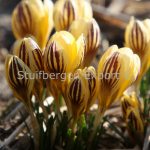
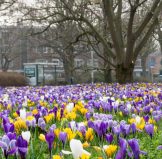 Crocus Specie Mixed
Crocus Specie Mixed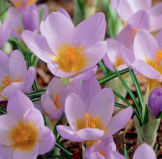
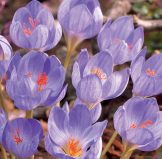 The superb blue Autumn Crocus, blooms in early to mid-autumn, arriving to brighten the garden at a time when many other plants have finished blooming. Autumn Crocus has large, sky-blue to purple flowers with golden-orange stigmas and anthers. They stand 4” tall and emerge without the narrow grassy foliage that will follow bloom. They will naturalize, and over the years, the clumps increase in size and duration of bloom.
The superb blue Autumn Crocus, blooms in early to mid-autumn, arriving to brighten the garden at a time when many other plants have finished blooming. Autumn Crocus has large, sky-blue to purple flowers with golden-orange stigmas and anthers. They stand 4” tall and emerge without the narrow grassy foliage that will follow bloom. They will naturalize, and over the years, the clumps increase in size and duration of bloom.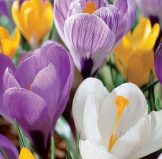 Giant Mixed Crocus Blend
Giant Mixed Crocus Blend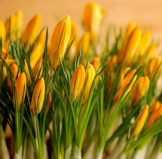
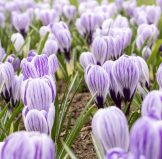
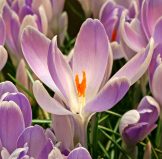
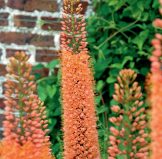
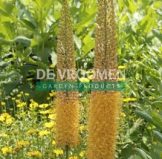 These sensational Steppe plants will be the highlight of your garden. Every year, the clumps grow larger with more dramatic stalks of yellow flowers resembling fox tails. Bees love them, and they make good cut flowers.
These sensational Steppe plants will be the highlight of your garden. Every year, the clumps grow larger with more dramatic stalks of yellow flowers resembling fox tails. Bees love them, and they make good cut flowers.
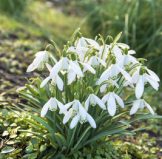 Pendant, bell-shaped white flowers with green-tipped petals are a classic harbinger of spring. They look wonderful planted in groups and may bloom as early as February. Commonly called snowdrop, this bulbous perennial is native to Europe and southwestern Asia.
Pendant, bell-shaped white flowers with green-tipped petals are a classic harbinger of spring. They look wonderful planted in groups and may bloom as early as February. Commonly called snowdrop, this bulbous perennial is native to Europe and southwestern Asia.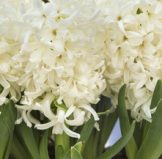 Bulb. Z4. 8-12” tall. Blooms mid-spring. Compost-improved soil.
Bulb. Z4. 8-12” tall. Blooms mid-spring. Compost-improved soil.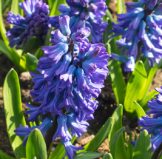 All these highly fragrant Dutch Hyacinth varieties are perfect for spring gardens and for forcing indoors in pots or hyacinth glasses. They are long-lived in the garden if fertilized after blooming, and after the first year they will produce more flower spikes that are less densely packed and more natural-looking. Hyacinths are quite easy to grow in a sunny or partly shaded spot.
All these highly fragrant Dutch Hyacinth varieties are perfect for spring gardens and for forcing indoors in pots or hyacinth glasses. They are long-lived in the garden if fertilized after blooming, and after the first year they will produce more flower spikes that are less densely packed and more natural-looking. Hyacinths are quite easy to grow in a sunny or partly shaded spot.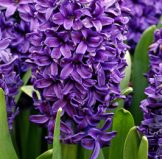 All these highly fragrant Dutch Hyacinth varieties are perfect for spring gardens and for forcing indoors in pots or hyacinth glasses. They are long-lived in the garden if fertilized after blooming, and after the first year they will produce more flower spikes that are less densely packed and more natural-looking. Hyacinths are quite easy to grow in a sunny or partly shaded spot.
All these highly fragrant Dutch Hyacinth varieties are perfect for spring gardens and for forcing indoors in pots or hyacinth glasses. They are long-lived in the garden if fertilized after blooming, and after the first year they will produce more flower spikes that are less densely packed and more natural-looking. Hyacinths are quite easy to grow in a sunny or partly shaded spot.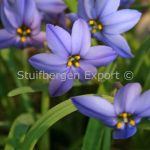 A spring gem for dry or moderately watered gardens in shade and part-shade. This long-blooming bulb from Chile and Uruguay sends up a mound of grassy foliage in autumn that persists over winter and begins blooming in early spring, producing a long succession of sweetly fragrant starry cobalt blue flowers through late spring, each atop its own 3”-6” stem. Multiplies to form a groundcover until summer when the foliage goes dormant. Also lovely planted under taller mid-spring bulbs such as ‘Tete a Tete’ miniature daffodils.
A spring gem for dry or moderately watered gardens in shade and part-shade. This long-blooming bulb from Chile and Uruguay sends up a mound of grassy foliage in autumn that persists over winter and begins blooming in early spring, producing a long succession of sweetly fragrant starry cobalt blue flowers through late spring, each atop its own 3”-6” stem. Multiplies to form a groundcover until summer when the foliage goes dormant. Also lovely planted under taller mid-spring bulbs such as ‘Tete a Tete’ miniature daffodils.
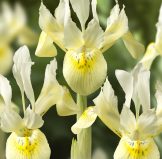
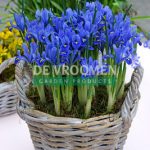
 Iris Blue Hill is an outstanding recent introduction. This sweetly scented little gem has good-sized saturated blue flowers with darker blue and prominent yellow blotches on the falls. Flowers are held on strong 4-5” stems, and each bulb will produce a succession of blooms over a couple of weeks in late winter, along with a marvelous fragrance.
Iris Blue Hill is an outstanding recent introduction. This sweetly scented little gem has good-sized saturated blue flowers with darker blue and prominent yellow blotches on the falls. Flowers are held on strong 4-5” stems, and each bulb will produce a succession of blooms over a couple of weeks in late winter, along with a marvelous fragrance.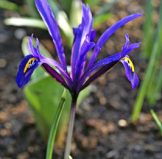 An irresistible little iris that grows no more than 5-6″ tall. Its dazzling, royal blue petals have showy white and yellow markings and the flowers are sweetly fragrant! Perfect for rock gardens or along a walkway where the soil is well-drained and relatively dry. Blooms in late winter along with the crocuses.
An irresistible little iris that grows no more than 5-6″ tall. Its dazzling, royal blue petals have showy white and yellow markings and the flowers are sweetly fragrant! Perfect for rock gardens or along a walkway where the soil is well-drained and relatively dry. Blooms in late winter along with the crocuses.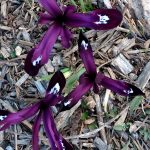
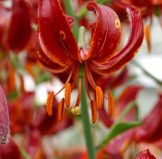
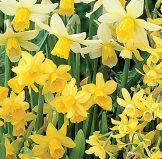
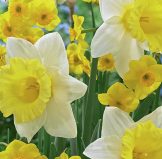

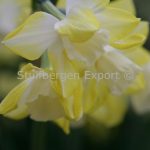 6” tall. This winner of the RHS Award of Garden Merit has extremely fragrant, soft yellow flowers that stand out against the narrow, dark green tubular foliage for an eye-catching display in mid-spring. Each stem can produce 4-5 blossoms. As the flowers mature, the dainty trumpet-shaped cups turn ivory white. ‘Pipit’ is vigorous, will multiply rapidly and can be left undisturbed for years. Plant it where its wonderful fragrance can be enjoyed! It also makes a great cut flower for small arrangements. Hardy to Zone 4. Plant 4″ apart. Deer and rodent-proof.
6” tall. This winner of the RHS Award of Garden Merit has extremely fragrant, soft yellow flowers that stand out against the narrow, dark green tubular foliage for an eye-catching display in mid-spring. Each stem can produce 4-5 blossoms. As the flowers mature, the dainty trumpet-shaped cups turn ivory white. ‘Pipit’ is vigorous, will multiply rapidly and can be left undisturbed for years. Plant it where its wonderful fragrance can be enjoyed! It also makes a great cut flower for small arrangements. Hardy to Zone 4. Plant 4″ apart. Deer and rodent-proof.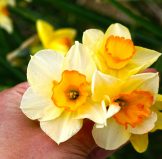

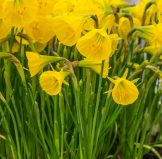
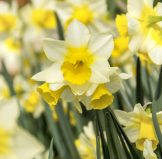
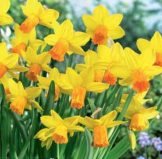 An old favorite for naturalizing, and another Cyclamineus daffodil. Bright and cheerful in the garden, with reflexed vivid yellow petals and orange-red trumpet. ‘Jetfire’ is early blooming, and increases rapidly to form showy colonies. Very long-blooming, tough and adaptable. Also good for forcing indoors.
An old favorite for naturalizing, and another Cyclamineus daffodil. Bright and cheerful in the garden, with reflexed vivid yellow petals and orange-red trumpet. ‘Jetfire’ is early blooming, and increases rapidly to form showy colonies. Very long-blooming, tough and adaptable. Also good for forcing indoors. While ‘Altruist’ Narcissus has the classic daffodil look, the colors are anything but ordinary! This striking award-winner has a 3″ coppery golden-orange perianth that pales as it matures, the perfect background for the shallow, bowl-shaped crimson-orange cup. Altruist is long-lived and floriferous, and its unusual and gorgeous coloring make it a stand-out in the garden and as a cut flower. Pest-proof!
While ‘Altruist’ Narcissus has the classic daffodil look, the colors are anything but ordinary! This striking award-winner has a 3″ coppery golden-orange perianth that pales as it matures, the perfect background for the shallow, bowl-shaped crimson-orange cup. Altruist is long-lived and floriferous, and its unusual and gorgeous coloring make it a stand-out in the garden and as a cut flower. Pest-proof!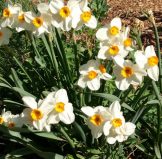 This very floriferous 1930 Heirloom tazetta hybrid should be planted where you’ll notice and enjoy its strong and heavenly perfume. The late-midseason blooms have a dainty orange-red cups surrounded by large pure white petals and the bulbs produce many out-facing flowers on each 14”-16” stem and increase well, making a striking display and provide wonderful fragrant cut flowers.
This very floriferous 1930 Heirloom tazetta hybrid should be planted where you’ll notice and enjoy its strong and heavenly perfume. The late-midseason blooms have a dainty orange-red cups surrounded by large pure white petals and the bulbs produce many out-facing flowers on each 14”-16” stem and increase well, making a striking display and provide wonderful fragrant cut flowers.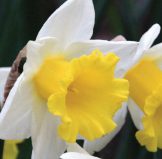 Cornish King Daffodil
Cornish King Daffodil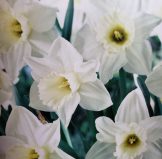 Breathtaking pure white flowers. Grows to 14” tall. Plant 6” deep and 6” apart in full sun to light shade. Deer and rabbit resistant.
Breathtaking pure white flowers. Grows to 14” tall. Plant 6” deep and 6” apart in full sun to light shade. Deer and rabbit resistant.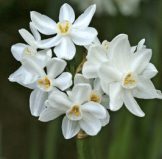 Potted Paperwhites bring intoxicating fragrance to your home in winter, and make wonderful holiday gifts. Bears trusses of heavily-scented, pure white flowers on up to three stems per bulb. They may be planted in all kinds of decorative pots, vases and trays, either in soil or pebbles, September through February. Rodent-proof.
Potted Paperwhites bring intoxicating fragrance to your home in winter, and make wonderful holiday gifts. Bears trusses of heavily-scented, pure white flowers on up to three stems per bulb. They may be planted in all kinds of decorative pots, vases and trays, either in soil or pebbles, September through February. Rodent-proof.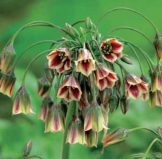
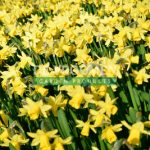 One of the best heirloom award-winning Cyclamineus daffodils, we have grown this miniature variety in our Xeriscape Rock Garden for many years. The graceful, floriferous early-bloomer has a reflexed, buttercup-yellow perianth surrounding a trumpet-like, darker yellow cup. For naturalizing, rock gardens, border plantings, and forcing. Hardy to Zone 4, 6” – 7” tall, Deer and rodent-proof! Plant 6” deep, 3-6″ apart.
One of the best heirloom award-winning Cyclamineus daffodils, we have grown this miniature variety in our Xeriscape Rock Garden for many years. The graceful, floriferous early-bloomer has a reflexed, buttercup-yellow perianth surrounding a trumpet-like, darker yellow cup. For naturalizing, rock gardens, border plantings, and forcing. Hardy to Zone 4, 6” – 7” tall, Deer and rodent-proof! Plant 6” deep, 3-6″ apart.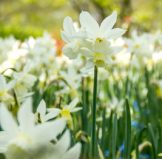 Lovely, snow-white, fragrant, award-winning Triandrus Narcissus ‘Thalia’ is a gracious, natural beauty that has been a perennial favorite since its introduction in 1916. Thalia bears two to three, pendant, star-shaped flowers per stem, poised above slender, deep green foliage. Also known as the ‘Orchid Narcissus’, this demure heirloom has graceful, spreading, slightly recurved flower petals encircling a long, slightly ribbed, cup-shaped crown. Unlike most ‘white’ narcissi, Thalia opens white and remains white. As long-lived Thalia naturalizes and matures over the years, it may bear up to five flowering stems per bulb in mid-spring.
Lovely, snow-white, fragrant, award-winning Triandrus Narcissus ‘Thalia’ is a gracious, natural beauty that has been a perennial favorite since its introduction in 1916. Thalia bears two to three, pendant, star-shaped flowers per stem, poised above slender, deep green foliage. Also known as the ‘Orchid Narcissus’, this demure heirloom has graceful, spreading, slightly recurved flower petals encircling a long, slightly ribbed, cup-shaped crown. Unlike most ‘white’ narcissi, Thalia opens white and remains white. As long-lived Thalia naturalizes and matures over the years, it may bear up to five flowering stems per bulb in mid-spring.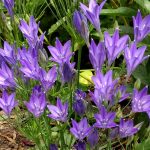 A wonderful Western US native wildflower bulb valued for its clusters of violet-blue, upward-facing flowers. ‘Queen Fabiola’ is lovely companion for relatively short perennials that bloom in May and June, like ‘Coral Canyon’ Twinspur or ‘Elfin Pink’ Beardtongue. It also makes a long lasting and graceful cut flower. The dark green foliage is slender and grass-like. ‘Queen Fabiola’ is easy to grow in full sun or morning sun and well-drained soil.
A wonderful Western US native wildflower bulb valued for its clusters of violet-blue, upward-facing flowers. ‘Queen Fabiola’ is lovely companion for relatively short perennials that bloom in May and June, like ‘Coral Canyon’ Twinspur or ‘Elfin Pink’ Beardtongue. It also makes a long lasting and graceful cut flower. The dark green foliage is slender and grass-like. ‘Queen Fabiola’ is easy to grow in full sun or morning sun and well-drained soil. Pacific Rim Daffodil
Pacific Rim Daffodil Blueberry Ripple Tulip
Blueberry Ripple Tulip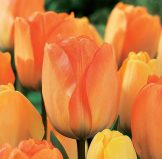
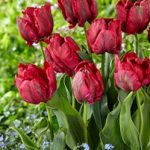
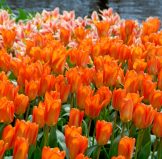
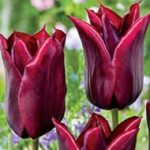

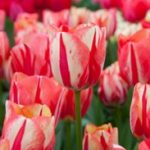
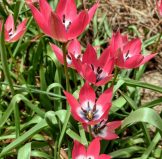 These adorable Species Tulips have reddish-pink petals with glowing, blue-eyed centers.
These adorable Species Tulips have reddish-pink petals with glowing, blue-eyed centers.

